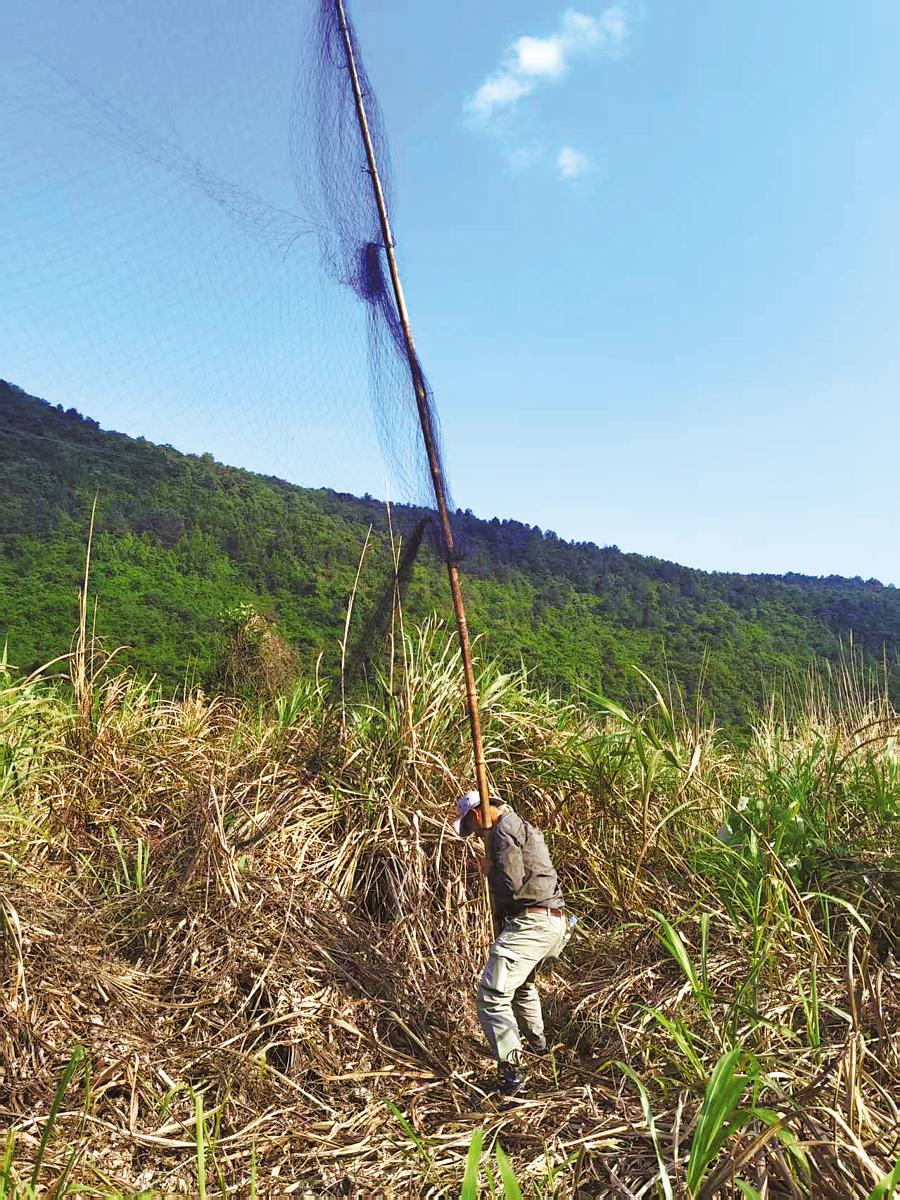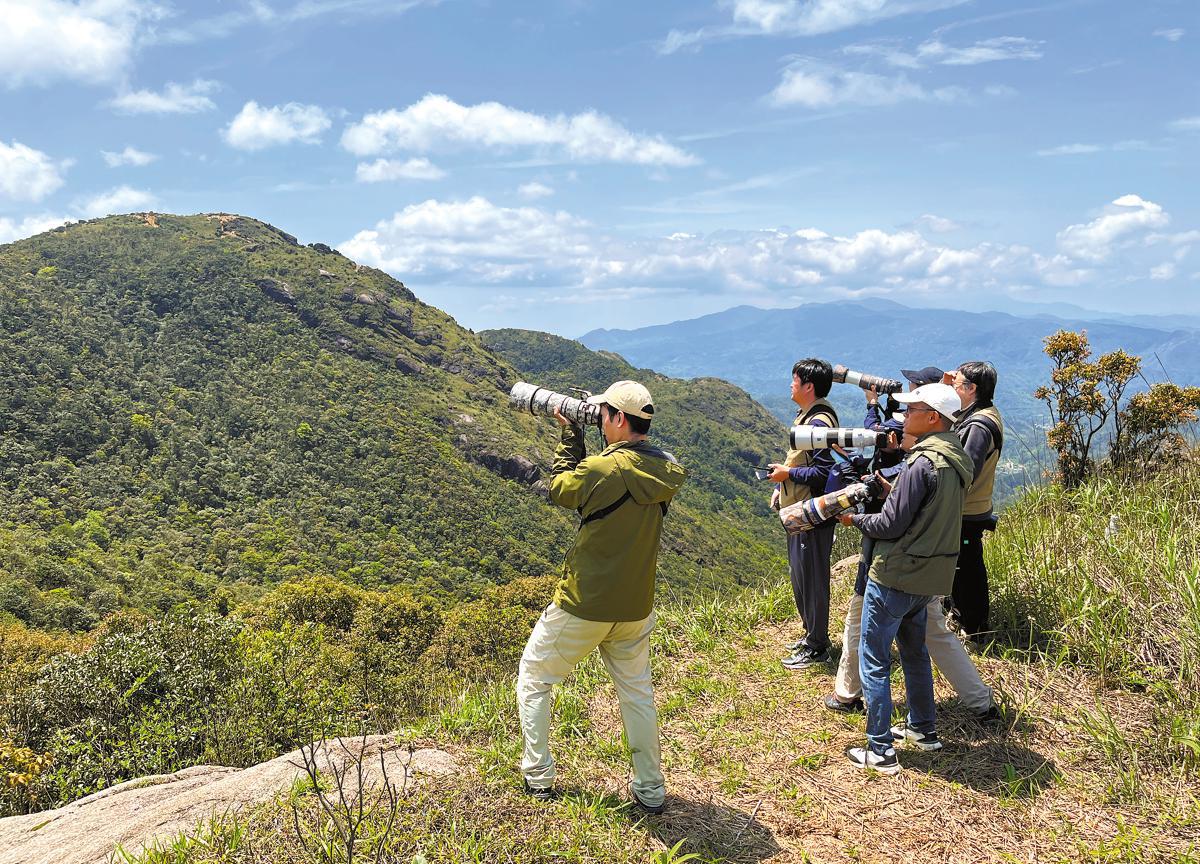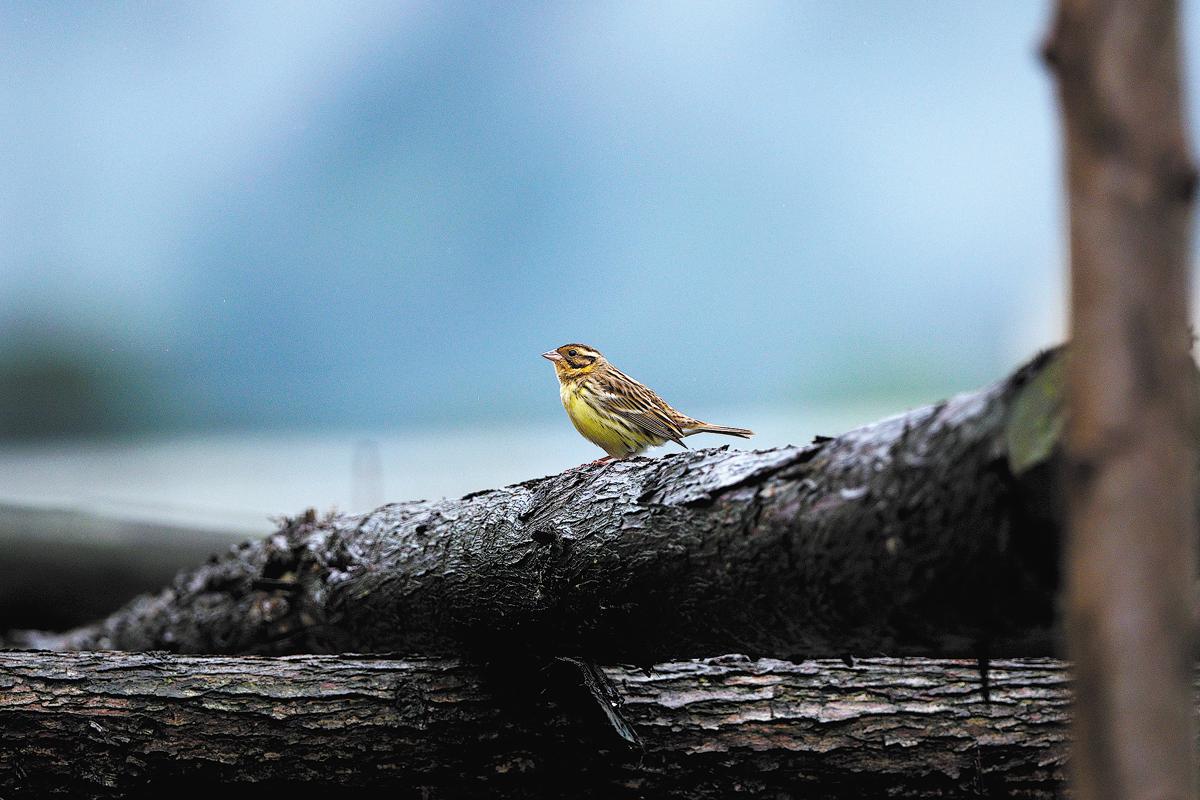
A team of bird-watchers participating in the fourth Nanling Bird-watching Carnival walk on a road running through the Nanling National Nature Reserve during the event held from April 26 to 29. MA ZHIYU/FOR CHINA DAILY
Enthusiasts 'race' to survey species in protected areas in Guangdong, Hunan provinces
It's truly hard to find anything in common between a 58-year-old retired businessman enjoying his retired life in Beijing, and a young college student studying biology at a university in Changsha, Hunan province.
However, they have teamed up twice already this year and competed together in a special kind of race — a bird race.
Bird races are events where participants "race" to identify bird species within and specific area and timeframe. The participant or team that identifies the most species is declared the winner.
Zhao Meisheng has been observing and photographing birds in his spare time for over two decades. However, it was only after his retirement a few years ago that he began to take this hobby more seriously.
"Previously, I focused mainly on bird photography, but now I dedicate more time to bird-watching," he said.
Zhao has started using a smartphone-based recording tool to document and manage his bird sightings. He actively participates in bird surveys as a volunteer and joins bird races held across the country.

A bird-watcher takes apart a mist net illegally set up in a field outside of the Nanling National Nature Reserve during the bird race. ZHAO JINFU/FOR CHINA DAILY
During a bird race in March in Wuhai city, Inner Mongolia autonomous region, Zhao found himself teamed up with two students from Central South University of Forestry and Technology, as they needed a driver for the competition. "The two students couldn't drive, and I am a pretty good driver," Zhao said.
His teammates were Huang Canxia and Zhou Jiaxi, both senior students from the university in Changsha. Huang, who delved into bird-watching in 2023, quickly developed a deep fascination for the hobby. Having already taken part in a dozen bird races, she boasts a list of 652 wild bird species spotted in the country.
The trio's synergy in Wuhai was remarkable. Upon learning about a bird race organized by two nature reserves in Hunan and Guangdong provinces during the Wuhai race, they decided to apply as a team once more.
As a result, they became one of the 32 teams participating in the fourth Nanling Bird-watching Carnival.
"I took part in the third Nanling bird race last year, which was exclusively hosted by the Nanling reserve in Guangdong," Huang said. "This year's event is much bigger."

Two teams of the carnival's participants watch birds from a peak straddling Guangdong and Hunan provinces on April 28. ZHANG SIMING/FOR CHINA DAILY
Spanning two provinces
According to Liu Zhifa, deputy head of the Guangdong Nanling National Nature Reserve's publicity and education department, the Nanling reserve borders the Mangshan National Nature Reserve in Hunan along the ridgeline of the Nanling Mountains, which straddle both provinces.
"We are on the southern slope and they are on the northern slope," Liu said. "We are protecting the same ecosystem. So a bird race held in both reserves will mean a more comprehensive bird survey for the area."
He traveled between the provinces four or five times to coordinate the event with his counterparts in the Mangshan reserve.
Finally, on the morning of April 26, the carnival kicked off in the Mangshan reserve in Yizhang county, Hunan. Besides the 96 contestants for the 84-hour bird race, bird experts invited by the organizing committee as judges of the race, rangers from both reserves and hundreds of local people attended the opening ceremony held in front of the Mangshan National Forest Park entrance.
Zou Bangxian, an official from the Forestry Administration of Guangdong Province, expressed his hopes for the event to serve as a catalyst for fostering greater collaboration between the provinces in areas such as ecological corridor development along the Nanling Mountains, coordinated species protection and shared natural education.
"By leveraging the ecological advantages of the Nanling Mountains for high-quality development, we expect that the event can contribute the wisdom of Guangdong and Hunan to national ecological civilization construction ... and deepen ecological cooperation between the two provinces through concrete actions," he said.
The management bureaus of the two reserves signed a strategic cooperation framework agreement, outlining their commitment to comprehensive cooperation in resource management, scientific research and monitoring, public education, and outreach and community engagement.
"In the future, I think we will approach our conservation issues with a wider perspective," said Li Yonghui, Party secretary of the Mangshan reserve. "We will consider solutions that encompass the entire mountain range rather than focusing on individual reserves."

A yellow-breasted bunting takes a break in a patch of farmland near the town of Mangshan in Hunan province on April 27. ZHAO MEISHENG/FOR CHINA DAILY
Sharing sightings
For the contestants, the event was a two-phase race. They spent two nights in the town of Mangshan, bird-watching along three suggested routes in and around the reserve.
On April 27, they drove from Mangshan National Forest Park to the headquarters of the Nanling reserve in Ruyuan Yao autonomous county, Guangdong.
This journey took them through Nanling National Forest Park, the core area of the Nanling reserve. They spent three nights and two full days exploring the reserve's five recommended routes. On April 26, Zhao, Huang and Zhou began their race at 6:30 am and returned around 7 in the evening.
The weather in the first two days was gloomy, with intermittent drizzle. Even when it wasn't raining, mists shrouded the peaks and valleys in Mangshan National Forest Park, making it truly challenging to search for birds in the dense forest.
"Birds are not active in bad weather," Zhao said. "Even though bird songs can be the only requirement for a decent record, you can harvest nothing when the birds stop singing."
On the first day of the race, the team recorded 50 bird species.
"It was a little less than we expected," Huang said.
Meanwhile, Le Weiqiang, a seasoned birder from Guangzhou, was invited to be one of the race's judges due to his extensive knowledge of the region's avian life.
Deciding to explore a section of farmland just outside Mangshan town, Le said: "It's right in the migration season. Bad weather might push some migratory birds to make a stopover in some less obvious places."
In a small rapeseed field, Le and Liu Zhifa spotted dozens of buntings — small seed-eating birds about the size of a sparrow.
"There are five species here, including a dozen yellow-breasted buntings, which are critically endangered according to the International Union for Conservation of Nature," Le said.
Later, they shared these sightings with a few of the contestants.
"This patch of farmland can be quite productive during the migration season," Liu said. "We hope more teams visit the site as it might yield more records. After all, a bird race is more akin to a bird survey than a competition. True birdwatchers are always eager to share their discoveries."
The next morning, Zhao, Huang and Zhou visited the site. They successfully spotted the yellow-breasted buntings. Additionally, Huang and Zhou saw a golden-headed cisticola, a tiny songbird, though Zhao missed it.
"It's a lifer for me," Zhao said, referring to the bird-watching term for a first-time sighting. "It's normal to miss a lifer if you're not in the right place at the right moment."

An Oriental pratincole, photographed near the reserve, is proclaimed top bird of the race. PAN WEIYING/FOR CHINA DAILY
Memories linger
All of the teams and the judges moved to Wuzhishan, a small community where the Nanling reserve headquarters is located, on the evening of April 27.
Over the next three days, the weather improved, remaining bright and sunny. Since the Nanling National Forest Park has been closed to the public since 2018, the lack of human interference has made many wildlife species there bolder.
A family of three Cabot's tragopans, a pheasant under State first-class protection, frequented a site at the park, giving all the teams opportunities to admire them.
"One of the tragopans moved quietly from a distance to just several meters away from where I stood, feeding on fallen wildflowers with ease," said Liao Chanyun, a member of a team from another national nature reserve in Guangdong.
"It was a truly unforgettable moment for me."
By the end of April 28, Zhao and his teammates recorded 126 species and the total number of bird species recorded by the 32 teams reached 300.
One team discovered mist nets illegally placed in a patch of farmland near the boundaries of the nature reserve, intended to trap migratory birds. They promptly reported their findings to Liu. The reserve mobilized a group of rangers to dismantle and remove the nets, ensuring the safety of migratory birds in the area.
The race concluded at 6 pm on April 29, with Zhao and his team achieving a count of 150 bird species. Following the event, all participating teams collectively logged 313 bird species into the event's smartphone-based record app.
The judging panel commenced a review process that evening. Each team was scrutinized as they presented evidence and detailed their sightings of certain "suspicious" species — birds uncommon to the region or specific habitats.
The exhaustive review continued until 2:30 am on April 30, resulting in the refinement of the species list from 313 to 242.
"Our primary goal was to provide comprehensive and accurate bird records for the two reserves," said Le regarding the judging process.
Despite the rigorous vetting, Liu noted a significant improvement from the previous year, with this year's record boasting 32 additional species.
An exceptional find near the Nanling reserve, the Oriental pratincole, observed by three teams, emerged as a novel record for the reserve and was crowned the top bird of the race. The victorious team clinched the title by documenting a remarkable total of 175 bird species.
Following the conclusion of the event, teams wasted no time in sharing their trip reports and experiences from the race across social media platforms.
"As part of our guidelines, each team is expected to post an article or a video narrative online," Liu said. "We hope the memories of the event can endure a little longer."
Zhao harvested two lifers during the carnival, celebrating the conclusion of the race by sharing some good oolong tea he brought with his teammates.
"I brought a bottle of liquor from my hometown for the celebration," Huang said. "We shared it with other bird-watchers during our dinner after the race. Anyway, a bird race is truly a gathering of birders."
















